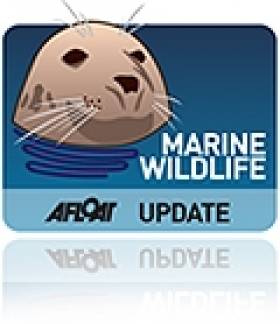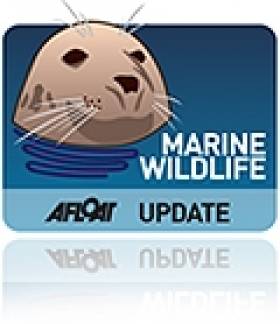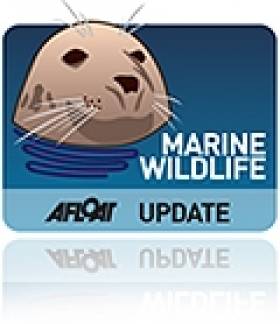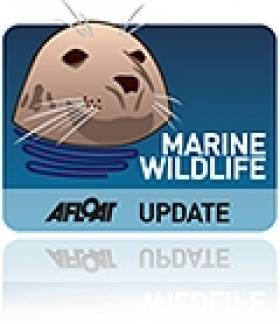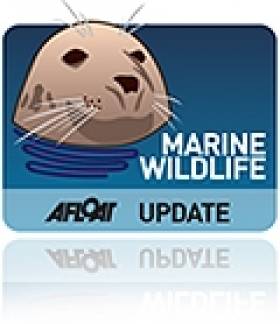Displaying items by tag: Dolphins
New Research Says Sonar Sends Whales Scurrying
#MarineWildlife - The Guardian reports on new research which proves that military sonar has a direct effect on the behaviour of whales in our oceans - even leading to mass strandings.
The studies, part funded by the US Navy, found that beaked whales where particularly sensitive to sonar - and that even blue whales, the largest animals on earth, were distracted from feeding by the subsurface noise.
It's long been feared that the use of sonar is to blame for unusual behaviour among whales, who navigate and communicate with each other over long distances using sound.
As previously reported on Afloat.ie, the Irish Whale and Dolphin Group (IWDG) identified sonar activity by Royal Navy submarines as a possible cause of a the mass stranding of pilot whales in Donegal in November 2010, in which as many as 35 whales died.
Now for the first time, sonar has been proven to affect behaviour of cetaceans to a detrimental degree, confirming for many a connection between the use of sonar technology and recordings of whale and dolphin strandings identified since the 1950s. The Guardian has much more on the story HERE.
In more positive whale-related news, the IWDG reports that its next Cape Clear summer whalewatching course over the weekend of 26-28 July is "filling up nicely".
Places are still available but as it coincides with the tourism high season in West Cork, anyone interested is advised to book sooner than later to ensure they have someone to stay nearby.
The most recent weekend course over the June bank holiday witnessed numerous harbour porpoises and common dolphins, but its hoped the elusive whales will make an appearance next time round!
Strange Case of Stranded Dolphin Found Two Miles Inland
#MarineWildlife - In a week that saw the Isle of Man's first sighting of a humpback whale for three years, BBC News reports on the strange discovery of a rare species of dolphin two miles inland from the shore in Co Donegal.
The carcass of an Atlantic white-sided dolphin was found on a hillside near Meenbanad with head injuries - but no one knows how it got there.
Pádraig Whooley of the Irish Whale and Dolphin Group (IWDG) said it's most likely that someone found the dead cetacean on the beach and took it to the hillside to decay so that its skeleton could later be retrieved.
The dolphin is thought to be one of a pod that beached at Traigheanna Bay in Dungloe on 21 June. The species is a rare sight in Irish coastal waters, said Whooley, because they tend to feed much further out at sea.
In other stranding news, the IWDG reports that a bottlenose dolphin who live stranded at Beal in Co Kerry last summer has been recorded in the Shannon Estuary with her calf on a number of occasions this month and last.
The Shannon Dolphin and Wildlife Foundation has more on the sightings of the dolphin they now call Sandy Salmon.
Shannon's First Recorded Dolphin Spotted Again 20 Years On
#MarineWildlife - The 21st year of dolphin research in the Shannon Estuary is off to an amazing start after the first ever dolphin recorded in the estuary was spotted on the Kerry coast.
As the Shannon Dolphin and Wildlife Foundation (SDWF) reports, the dolphin known as 'No 1' was sighted in Brandon Bay on Saturday 25 May swimming in a group of three.
No 1 is happily a familiar sight in the region, having been recorded most years since the project began in 1993.
"It has long been known that Shannon dolphins regularly use Tralee and Brandon Bays but how important the area is in not clear," says the SDWF on its blog. "If we are to protect the Shannon dolphins we need to ensure we identify all their important habitats and extend protection to these areas if necessary."
Meanwhile, its been confirmed that the trio of bottlenose dolphins who took up residence near Bunratty Castle in the spring have been observed in the mainstream of the Shannon Estuary.
The three were spotted on the first monitoring trip of the summer from Kilrush last week by SDWF researchers of Moneypoint.
"This demonstrates again the value of long term monitoring and the power of a photo ID catalogue to monitor the Shannon dolphins," says the SDWF blog.
In other cetacean news, an in-depth discussion of the Shannon's dolphins and the Irish Whale and Dolphin Group's (IWDG) research of bottlenose dolphins around the Irish coastline was broadcast on Derek Mooney's afternoon show on RTÉ Radio 1 recently.
A podcast of the 30-minute segment of Mooney Goes Wild from Friday 31 May is available to download HERE.
Dolphins 'Say Thank You' After Fish Farmer Rescue
#MarineWildlife - Two dolphins saved from stranding on a beach in Donegal leapt from the water "as if to say thank you" after their rescue by a local fish farmer.
The Belfast Telegraph reports that salmon farmer Shea Coyle and his father Michael acted quickly after noticing what at first looked like two upturned surfboards on Downings beach near Fanad.
But what looked from afar like surfboard fins turned out to be the fins of two dolphins that had become trapped in the sand.
Shea described how the dolphins were "trying desperately to wriggle free" before he leant a hand to heave them back into the water.
"After about 10 minutes I got one dolphin safely out into deeper water and he stayed there whilst I got to work on the other."
Once the second dolphin was free, the pair "just took off" - and were later seen by the Coyles from a nearby peer, giving what might just have been a show of thanks.
The happy story in Donegal occurred not long after a series of dolphin and whale strandings in the northwest described as "unusual" by the Irish Whale and Dolphin Group (IWDG).
'Unusual' Dolphin, Whale Strandings In Northwest
#MarineWildlife - Seven dolphins and two beaked whales have stranded on beaches in the northwest in events described as "unusual" by the Irish Whale and Dolphin Group (IWDG).
On the Mullet Peninsula, a group of seven common dolphins - comprising five adults and two juveniles - live stranded at Tarmon Beach on Sunday 12 May.
Though initial attempts to refloat them were successful, one of the juveniles was later found dead and the other was euthanised due to poor health.
Meanwhile in Donegal, the fresh carcass of a female True's or Sowerby's beaked whale was found on Sunday evening on Five Fingers Stand at Inishowen - some days after a reported live stranding of a Sowerby's beaked whale on the Welsh coast.
The Inishowen stranding was followed yesterday 14 May by the discovery of a dead beaked whale calf at Trawbreaga Bay, in what is believed to be a connected stranding.
Samples of the adult female were taken in order to confirm the species, either of which would mark a rare cetacean record for Ireland - the first since 2009.
#DolphinExhibition - Balbriggan Maritime Museum has opened a new public display in Balbriggan Tourist Office on Quay Street near Balbriggan Harbour.
On show is a Whale and Dolphin Exhibition, bones, models and general information to celebrate the biodiversity of sea mammals off the coast. This follows the previous popular 'Cannon Balls Exhibition'.
Appropriately, 'Water & Biodiversity' is the theme of the 2013 International Day for Biological Diversity which falls on Wednesday, 22nd May.
Balbriggan Maritime Museum volunteers have assembled bones from many sea animals, such as a vertebra from a Fin Whale, the second largest whale in the world growing to 88ft in length. No wonder this bone is too heavy for one person to lift!
The Humpback Whale model, in real life, is about half the length of a Fin Whale and weighs only 40 tonnes! Even so, Humpback Whales, which are seen in the Irish Sea, would be too big to fit into Balbriggan Courthouse!
Smaller skulls from Common Dolphin, Pilot Whale and Grey Seal, as well as a Minke Whale jawbone can also be examined during May when this Whale and Dolphin Exhibition will be on display from Tuesday to Sunday when the Balbriggan Tourist Office is open.
#MarineWildlife - The Irish Whale and Dolphin Group (IWDG) is marking 20 years of researching the dolphins of the Shannon Estuary.
As the IWDG's Dr Simon Berrow relates, it was not an auspicious start on 2 May 1993 when the first research trip on the estuary returned after five hours without having seen a single cetacean.
But the following day brought a bounty, with 16 dolphins across three different groups located by the IWDG - the beginning of two decades of sightings and recordings for the Shannon Dolphin Project, which has identified around 230 individual dolphins to date.
Thanks to that project, we know today that at least six of those dolphins first seen in 1993 are still in the estuary as of last year.
The Shannon Dolphin Project now has a website explaining its achievements and the work of the Shannon Dolphin and Wildlife Foundation (SDWF) over the years.
Meanwhile, Afloat reader Karl Grabe has also produced a spectrogram and edit of hydrophone recordings captured by Dr Berrow of Shannon dolphins just a few weeks ago.
Grabe previously uploaded a wonderful snippet of dolphins vocalising in the estuary late last year.
Dingle's Fungie May Have Come From British Dolphinarium
#Fungie - An Irish marine expert suspects that Dingle's most famous resident may be an escapee from a British dolphinarium.
Dingle Oceanworld director Kevin Flannery told the Irish Independent that Fungie the dolphin could have slipped through the sluice gates of any one of a number of dolphinariums on the south coast of England amid "huge objections to holding marine animals in captivity".
As previously reported on Afloat.ie, the male bottlenose dolphin appeared out of nowhere in Dingle's harbour in 1983 and has made his home there ever since.
In the three decades from then he has been credited with having "rescued" the village as his frolics brings countless tourists to the peninsula every year, as Flannery told the Irish Examiner.
This week's Féile na Bealtaine in Dingle celebrates the 30th anniversary of the arrival of the Kerry village's cetacean mascot, and many visitors are expected to line up for boat trips out of the harbour to meet him face to face.
While the Irish Whale and Dolphin Group (IWDG) doesn't recommend swimming with a wild dolphin such as Fungie, the group's Nick Massett describes him as "friendly, intelligent, and very aware of where people [are] in the water".
Among the festival activities this week will be a film screening and exhibits paying tribute to Ireland's own 'Flipper'.
Féile na Bealtaine runs from 2-6 May with events throughout the Dingle Peninsula.
Bunratty Dolphins Move On To Deeper Waters
#MarineWildlife - The trio of bottlenose dolphins who took up residence close to Bunratty Castle recently have apparently moved back out to deeper water after growing concerns for their well-being.
As previously reported on Afloat.ie, the dolphins had made their home opposite Durty Nellys pub in the Ratty River, which flows into the Shannon Estuary.
Simon Berrow of the Irish Whale and Dolphin Group (IWDG) explained that it's not unusual for dolphins to forage for food in waterways that feed into the estuary, though they usually return to the main catchment on their own shortly after.
With fears that their acoustic abilities were impaired, preventing them from navigating downstream past a series of bridges and concrete pillars between them and the main watercourse, a rescue attempt had been planned for late last week.
But as the Clare People reports, this was called off as the dolphins were spotted less and less frequently in the area.
Later hydrophone tracking by the IWDG led experts to discover that the cetaceans were able to come and go as they pleased.
Despite this, dolphins only have a limited ability to survive in fresh water, and can develop serious kidney and skin problems if exposed for a significant length of time.
Dolphin Trio At Home Near Famous Watering Hole
#MarineWildlife - Three bottlenose dolphins have made a new home close to a famous tourist watering hole in Co Clare.
According to the Irish Independent, the trio have taken up residence next to Durty Nellys pub in the Ratty River, which flows past Bunratty Castle into the Shannon Estuary.
The Irish Whale and Dolphin Group (IWDG), which has been tracking the group, believes they originated from a larger group populating the estuary.
As the IWDG's Simon Berrow explains, such dolphins are known to forage for food in rivers that feed into the estuary, and will return to the main catchment on their own.
While the risk of stranding in the shallower waters of rivers is unlikely, there is growing concern that the dolphins have been in the area for longer than expected.
"We can't rule out the possibility that their acoustic abilities may be impaired by the series of bridges and concrete pillars that span one of the bridges, and that they may be finding it difficult to navigate as a result of an 'acoustic trap'," says Berrow.
The IWDG says it is in discussion with the National Parks and Wildlife Service as to what options are available to step in to shepherd the trio back to the Shannon Estuary if necessary.






























